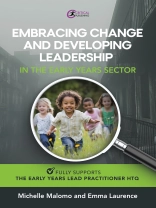This contemporary guide for early years practitioners and students delves into the adversity and challenges faced by the EY sector in recent times. It offers hope as it champions the unique knowledge, skills and behaviours of the EY practitioner and how they can exercise individuality in response to the diverse needs of children and their families in today’s society. In addition it is fully mapped to the requirements of the new Early Years Lead Practitioner HTQ.
In recent years, early years practitioners have faced significant turbulence, including the Covid-19 pandemic, the cost-of-living crisis, climate instability, and the underfunding and closure of childcare provision. These challenges have necessitated a re-evaluation of what it means to flourish as humans, how this can be nurtured in children, and ultimately how to optimise practice in the EY sector. The sector now has a unique opportunity to redefine its vision for children in our society. Structured to inspire, chapters delve into six key themes: the educator and developer of children, the custodian, the planner, the advocate, the collaborator, and the innovator.
This book offers a reflective and challenging stance to critically evaluate the intentions that underpin EY policy and practice and how to reimagine practice in these changing times so that it aligns with child-centred values. Content is closely aligned with the new Early Years Lead Practitioner HTQ, positioning it as an essential resource for this qualification. It includes critical questions, reflective exercises, and case studies, enabling readers to directly apply their knowledge to practice and use this text as a comprehensive, one-stop guide.
Tabla de materias
Introduction
Theme one – The educator and developer of children
Chapter 1 – The child at the centre of their development
Chapter 2 - Supporting children to be healthy and well
Theme two – The custodian
Chapter 3 – Understanding, applying, and managing legislation and regulatory frameworks
Chapter 4 – Leading practice to reflect current and emerging social policy
Theme three – The planner
Chapter 5 – It’s child’s play – playful curricula and spaces
Chapter 6 – Facilitating child-centred practice
Theme four – The advocate
Chapter 7 – Let’s get it right: safeguarding
Chapter 8 – Childhood: it’s their world – a global and sustainable approach
Theme five – The collaborator
Chapter 9 - Leading change, practice within organisations
Chapter 10 – Collaboration: the power of multi-agency working
Theme six –The innovator
Chapter 11 – How do I undertake my first practice research project?
Chapter 12 – Innovative, appreciative, and impactful research
Conclusion and where next?
Index
Glossary
Sobre el autor
Emma Laurence is a lecturer in the Department for Children and Families at the University of Worcester, and is also studying there for a Ph D in Educational Leadership. Her current research centres on how cluster groups of headteachers can provide a unique source of support. Prior to this she achieved a BA (Hons) in Early Childhood and an MA in Education before completing her PGCE with Teach First. Emma’s interest is in human development, both individually and communally, meaning her work spans education and care across all ages and well beyond the school environment. Emma has had work published internationally in academic journals and practitioner handbooks.












